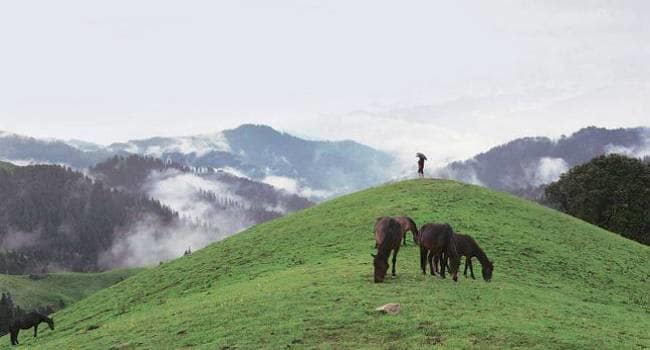A mountain is a natural rise of the Earth’s surface that usually has a “summit” (or “top”). It is usually steeper and taller than a hill. Mountains are often thought of as being a hill of over 600 meters.
India has some of the highest mountain ranges and mountain roads in the world. India is home to seven major mountain ranges that have peaks of over 1000 meters.
The most famous and the highest mountain range in India is the Himalayan range. It is also the youngest and the longest mountain range in India and has almost every largest peak in the world. The Himalayan mountain range bisects India from the rest of Asia and is the primary source of mighty rivers in India.
India is surrounded by the great mountains, the Himalayas in the north, the Indian Ocean in the south, the Arabian Sea in the west and Bay of Bengal in the east.
The Mountain ranges in INDIA can be classified in numerous ways:
IN THE NORTH
India has the world’s highest and greatest ranges of mountains; the great Himalaya in the north that covers about 2500 kilometers in length. It has the highest peak. Mount Everest is the highest peak in the world which is about 8845 meters high. It is situated in Nepal.
The second highest peak is Kanchanjanga 8597 meters high and the third is Nanga Parbat 8125 meters high and the fourth in Nanda Devi which is 7816 meters high. All these are high peaks in the great Himalaya. The great rivers from Himalaya are the Ganga, Yamuna, Brahmaputra, Kosi, etc.
IN THE SOUTH
In the south, the great plateau of India consists of Nilgiri Mountains in the south, eastern ghat Mountains in the east and western ghat in the west. The northern side of the plateau consists of the mountains. Vindhyas in the Aravalli ranges. All the major rivers begin from the desert of Rajasthan, Mahanadi, Godavari, Krishna, Kaveri, flow from the Western Ghats and merge into the Bay of Bengal in the east and only one river, Narmada, is from eastern Ghats and flows into the Arabian Sea in the west. The river Tapti flows from the Aravalli range, which touches the marble rock in Jabalpur and finally goes into the Arabian Sea. The only mountain peak in the south is Anaimundi in Kerala.
7 major mountain ranges in India
1. The Himalaya Range
- The highest mountain range of India, Himalaya literally translates to “abode of snow” from Sanskrit.
- The Himalayan Mountain is the youngest range of India and is a new fold mountain formed by the collision of two tectonic plates.
- The Himalayan Mountain Range has almost every highest peak of the world and on an average, they have more than 100 peaks with height more than 7200m.
- Nanga Parbat and Namcha Barwa are considered as the western and eastern point of the Himalayas.
- Mount Everest is the highest peak in the world at 8848m. It lies in the Himalayan Range in Nepal.
- The Himalayas is also the source of many great river ranges, including the Ganges, Brahmaputra, and Indus.
- The Himalayas also play a vital role in regulating the climate in northern India by preventing cold air from entering the Indian mainland in the winter season.
2.The Karakoram and Pir Panjal Range
- Karakoram Range and Pir Panjal Range lie to the North-west and south of the Himalayan Range.
- A major part of the Karakoram Range lies under the disputed category of Indian and Pakistan and both countries have declared a claim over it.
- Karakoram Range, with a length of 500km, holds many largest peaks of Earth. K2, the second-highest peak of the world, at 8,611m lies in the Karakoram Range.
- Hindu-Kush, an extension of the Karakoram Range runs in Afghanistan.
- The Karakoram has the most glaciers excluding Polar Regions. The Siachen Glacier and The Biafo Glacier, which are the world’s 2nd and 3rd largest glaciers, are located in this range.
- The Pir Panjal Range is located in the southern direction of Himalayas starting from Himachal Pradesh in India and running north-west towards Jammu & Kashmir and disputed area of Jammu & Kashmir.
- This range is also known as Lower Himalayas. Rivers like Ravi, Chenab, and Jhelum flow through this range. The city of Gulmarg, a very important hill station, lies here.
3. The Eastern Mountain Range or The Purvanchal Range
- The Purvanchal Range can be considered as the extension of Himalayas in the eastern part of India as the process of formation of this range is quite similar to that of Himalayas, although the range is not as high as the Himalayas.
- The Purvanchal Range or the Eastern Mountain Range comprises three parts: The Patkai-Bum Hill, The Garo-Khasi-Jaintia Hills and Lushai Hill (Mizo Hill).
- Mawsynram, in Meghalaya, is the wettest place on Earth because of these hills and it lies in the Khasi Hill.
- This range covers all the eastern states of India, which are commonly known as the Seven Sisters.
4. The Satpura and Vindhya Range
- The Satpura and Vindhya Range lie in central India and both these ranges run parallel to each other.
- Out of these two, the Satpura range is higher in length and is the source of rivers like Narmada and Tapti.
- Both Satpura and Vindhya are mainly situated in Madhya Pradesh and Maharashtra with some extension to Gujarat, Chattisgarh and Uttar Pradesh.
- Kalumar Peak (752m) and Duphgarh Peak (1350m) are the highest points in Vindhya and Satpura range.
- These ranges are famous for a large no of tourist spots like Panchmarhi Hill Station, Kanha National Park, Amarkantak and Omkareshwar temple.
5. The Aravalli Range
- The oldest mountain range of India, The Aravalli Range is also the oldest mountain range in the world. Width of the range varies from 10km to 100km.
- In the local language, Aravalli translates to ‘line of peaks’, and spans a total length of 800 km, covering the Indian states of Delhi, Haryana, Rajasthan, and Gujrat.
- Aravalli Range plays a very important role in Indian climate as it blocks wind carrying rain to reach the Thar Desert.
- Guru Shikhar is the highest point of Aravalli Range with a total elevation of 1722m.
- This range is famous for many tourist attractions and Mount Abu the only hill station in Rajasthan is situated on this range.
- The city of Udaipur also lies on its southern slope. The city of Udaipur, which is also known as Venice of the East, lies in the southern slopes of Aravalli Mountains.
- Banas, Luni, and Sabarmati are the rivers that flow through this range.
6. The Western Ghats
- The Western Ghats is a 1600 m long mountain range that runs from Gujrat to Kanyakumari in south India.
- This mountain range is also called “Sahyadri Mountains”.
- It comprises the mountain range of Nilgiris, Anaimalai, and Cardomom.
- Tapti River marks its beginning in Gujarat and then it runs parallel to Arabian Sea crossing states of Maharashtra, Goa, Karnataka, and Tamil Nadu.
- Anaimalai Hills with an elevation of 2695 m in Kerala is the highest peak of this range.
- Western Ghats is one of the UNESCO World Heritage Sites and has great bio-diversity.
- It is home for some 139 mammal species, 508 bird species, 179 amphibian species, and 250 reptile species.
- Famous tourist attractions include Jog falls, Ooty, Bandipur National Park.
- The Godavari, Krishna, and Kaveri are the important rivers in this range.
7. The Eastern Ghats
- The Eastern Ghats is mountain range running in the eastern part of Indian Peninsula parallel to the Bay of Bengal.
- This range is not continuous and is lower in elevation when compared to the Western Ghats. The range runs through Indian states of West Bengal, Orissa, Andhra Pradesh, and Tamil Nadu.
- Arma Konda with an elevation of 1680m is the highest peak of this region.
- The Eastern Ghats have a significant role in Indian agriculture as four major rivers of India i.e. Godavari, Mahanadi, Krishna, and Kaveri fall into the Bay of Bengal through the Eastern Ghats. They create a large fertile region which is suitable for crops like rice.
- These Ghats are older than the Western Ghats and they have some very important pilgrim sites like Tirumala Venkateshwara Temple in Andhra Pradesh.
- Vishakhapatnam and Bhubaneswar are important cities located in the Eastern Ghats.
Himalayan ranges are divided into three parts
(i) The Greater Himalayas-
The northernmost range of the ‘ Himalayas is called the Greater Himalayas. It is also known as the Hirradiri. This Greater Himalayas are of an average height of 6100 meters and is always snow-capped. This range has some of the highest peaks in the world. Mount Everest, Mount Kanchanjunga, Nanga Parbat, Nandadevi and Badrinath are some of them.
(ii) The Lesser Himalayas–
The great mountain wall of the North. The Himalaya is a protector of our country as it saves us from foreign powers. It also protects us from a severe cold wave in the winter. It helps us with rains as the Mountain clouds struck the mountains and cause rains.
The mountains give us so many things, such as various types of minerals, raw materials, dry fruits, green fruits and a variety of medicines which are planted and cultivated in hills.
It is also known as Himachal. This range is situated to the south of the Greater Himalayas and parallels to it. The average height of this range is 4000 meters. Many beautiful hill stations, nestle in the lesser Himalayas. Shimla, Mussoorie, Nainital, Kashmir, Kathmandu, Kangaroo and Kulflu valleys are some of them.
(iii) Outer Himalayas or Shivalik–
This is the southernmost range of the Himalayas. Its average height is 1000 meters. It is made; up of soil and pebbles which are called duns or duars. (Dehradun, Haridwar).
The highest peak of the Himalayas is Mount Everest which is situated in Nepal and is 8848 meters high. This peak is also the world’s highest peak,
The eastward continuations of the Himalayas beyond the Brahmaputra valley are collectively known as the Purvachal. They include the Patkaai Bum, Naga, Garo, Khasi, Jaintia, and Mizo hills. The Himalayas are known by different names from west to east,
(i) Kashmir Himalayas,
(ii) Punjab Himalayas,
(iii) Kumaon Himalayas,
(iv) Nepal Himalayas,
(v) Assam Himalayas.
Kashmir Himalayas, Punjab Himalayas, and Kumaon Himalayas together are called the western Himalayas.
The Deccan Mountains-
The Deccan Plateau is almost angular in shape. The Aravallis, the Vindhyas, and the Satpuras fountain lie in the northern part of the Deccan Plateau. The hills Ordering the Deccan plateau on the east are known as the Eastern hats. The Western flank of the Deccan plateau is known as western ghat or Sabyadari hills.
Rajmahal mountain range is situated at the southeastern part of Bihar. Nilgiri mountain is located in southern India at the meeting point of western and Eastern Ghats.
The high peak of the Nilgiri mountain is Dodabeta. Ooty the most beautiful station in south India is situated on the Nilgiri hills. ‘Mahendra. the mountain is in Orissa whereas the famous Bababudan Mountain (Iron Hill) is situated in the state of Kamataka.
There are mainly four plateaus in India:
(i) Malwa Plateau-
Situated in and around Madhya Pradesh
(ii) Chotanagpur Plateau-
It is situated in the state of Jharkhand and is popularly known as the store house of Indian Minerals.
(iii) Meghalaya Plateau–
It is situated in the north-eastern region of India.
(iv) Deccan Plateau-
It is situated in the southern part of India and is spread over in the states of Gujarat, Maharashtra Madhya Pradesh, Kama taka and Andhra Pradesh. The northern part of the plateau is known as the lava region or Deccan Trap.

